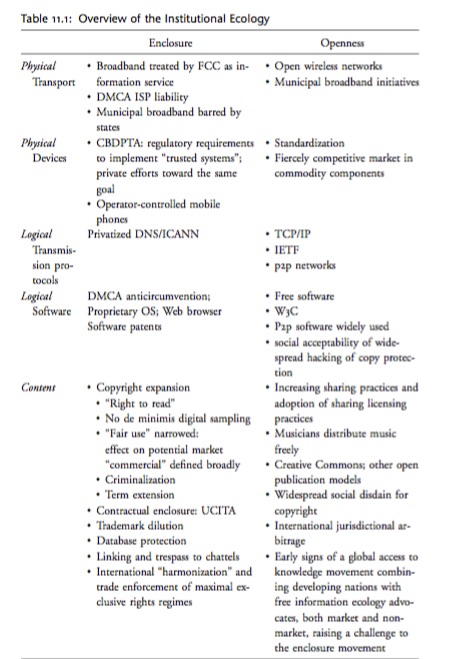On “The Battle Over the Institutional Ecology of the Digital Environment,” by Yochai Benkler
In yet another excellent chapter from The Wealth of Networks: How Social Production Transforms Markets and Freedom (2006), Yochai Benkler considers the digital environment (or sphere, or network, or whatever you like to call it), as an “institutional ecology.” He does this in order to examine the forces that shape the way we create, navigate, consume, and share electronic content, with a distinct eye to legal forces. Focusing on legal actions is critical; as Benkler notes, “we have seen a broad range of distinct regulatory moves surrounding the question of control over the basic resources needed to create, encode, transmit, and receive information, knowledge, and culture in the digital environment” (384).
Benkler’s basic premise is that there is “a battle over the institutional environment, and that many present choices interact to increase or decrease the availability of basic resources for information production and exchange” (394), and the majority of the chapter is devoted to institutional and legal changes in regards to regulating networked environments, with a focus on those that occurred in the US in the mid-90s. At a glance, Benkler offers this handy chart (395) as an overview of these changes, divided by their propensity toward enclosure or openness:
I found this chart useful as I asked myself how the university in general and academic publishing in particular fits within this framework of enclosure vs. openness. In this chapter, Benkler does reflect on the early (remember, he’s writing in 2006) attempts of scientists to make their research output more public, especially through initiatives like PLoS. But Benkler isn’t overwhelmingly impressed by academia in consideration of commons-based peer production and an open, networked environment: “The institutions of higher education,” he writes, “have been entirely ineffective at presenting their cultural and economic value and the importance of open Internet access to higher education, as compared to the hypothetical losses of Hollywood and the recording industry” (411). I do think that higher education has at least developed an interest in openness, and this is evident in MOOCs, OA journals, and sincere efforts toward deepening public engagement. I remain skeptical, however, as to whether this is truly evidence of a commitment to the “importance of open Internet access.”
Benkler builds his chapter around a specific framework of 3 basic functions of mediated communication: hardware /physical infrastructure, content (as well as its filtering and accreditation), and software / standards. As per Benkler, this framework is “intended to map how different institutional components interact to affect the answer to the basic questions that define the normative characteristics of a communications system—who gets to say what, to whom, and who decides?” (392). As you’ll see in the chart above, Benkler uses this framework in his forthcoming breakdown of the changes to the institutional ecology.
One of the most critical questions that Benkler asks, for me at least, is “Are we leaving enough institutional space for the social-economic practices of networked information production to emerge?” (393). When we apply Benkler’s framework and formulation to scholarly communication, as I’m apt to do, this becomes a tricky question. I would argue / assume that Benkler’s response to the above question is a resounding no: he is genuinely concerned with the increasing regulation of the networked environment, and its flux of corporate control (e.g., of personal computers and OS) and criminalization (e.g., of peer to peer sharing of cultural materials). But what would an unregulated, non-managerial system of academic knowledge production look like? Does a decentralized commons fit the bill for a community that has been built on an editorial tradition, and that is structured on hierarchical knowledge creation?
Benkler also makes a clear case for limiting copyright on cultural material. He asserts the importance of what we now call re-mix culture, although there are less flippant and more humanistically rooted ruminations on the relationship between artists and their predecessors, as well as the impossibility of working entirely in a vacuum (see Eliot’s “Tradition and the Individual Talent”). Benkler concludes that, due to copyright extension and regulations like the Digital Millennium Copyright Act (DMCA), “almost the entire stock of twentieth-century culture and beyond would stay privately owned, and its copyright would be renewed indefinitely” (443). The ramifications of this are clear for artists of all kinds, amateur and professional alike, who unlike the poet in Eliot’s essay do not have the luxury of using, warping, building upon, or integrating the work of previous artists, nor to have their own work become a patch in a different cultural quilt — or at least not explicitly.
Overall, Benkler offers a detailed account of the regulation of the networked environment up to his time of writing. In doing so, he reflects seriously on the dangers of corporate control of culture, and he waves the flag for commons-based peer production. He reminds his readers that “freedom to create and communicate requires use of diverse things and relationships—mechanical devices and protocols, information, cultural materials, and so forth” (391); if we hand over our cultural environment to those who want to lock it down and profit off of it, than we also relinquish our “freedom to create and communicate” — and that is a very sad thing indeed.
Works Cited
Benkler, Yochai. 2006. “The Battle Over the Institutional Ecology of the Digital Environment.” The Wealth of Networks: How Social Production Transforms Markets and Freedom. New Haven and London: Yale UP. 383-459.
Eliot, T.S. 1920. “Tradition and the Individual Talent.” The Sacred Wood. New York: Alfred A. Knopf. 42-53.
